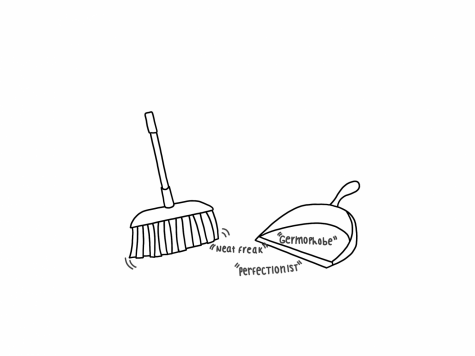Now trending: Mental illness
December 8, 2021
Content warning: The materials discussed within this article may evoke strong emotions as it discusses topics of depression, suicide and self-harm. If these topics are sensitive to you, please proceed with caution and access the mental health resources below.
When scrolling through TikTok, Instagram and Twitter, it is almost guaranteed to come across posts making light of serious mental illnesses. Although the majority of social media platforms restrict posting content regarding suicide or self-harm, usually by banning the usage of triggering terms, many of these restrictions are too loose and cannot block all potentially harmful content. Additionally, users can easily get around these social media guidelines by simply changing or distorting the spelling of specific terms, examples being ‘self h*rm,’ ‘suici*e’ and ‘sewercide.’ With these major loopholes, the romanticization and misrepresentation of mental illness on social media is rampant and hurting users every day.
According to TikTok’s analytics, the hashtag #mentalillness has approximately 1.6 billion views. Under this hashtag you can find a plethora of videos; some are jokes about mental illnesses, others are personal anecdotes of people’s experiences and many are point of view (POV) videos depicting what certain mental illnesses are stereotypically supposed to look like. Creators exaggerate and glamorize symptoms, like portraying Attention-deficit hyperactivity disorder (ADHD) as solely fidgeting and being energetic while excluding emotional impacts such as aggression, irritability and depression. These POV videos can be especially frustrating for those with these conditions as they rarely portray the illnesses accurately.
In a Vice article, Mason Smajstrla, a comedian with anxiety, explains her personal experiences with social media’s depiction of mental illness.
“I feel like I should be able to connect with these images, but I just can’t … I’ve judged myself for looking at a picture on Instagram of something centered around anxiety because it was only a small glimpse into what [anxiety] looks like, whereas my anxiety looks completely different,” Smajstrla said.
This is the downfall with these sorts of videos: they give a false perception of what mental illness is and how it presents itself by omitting the fact that mental illness looks different for everyone.
Another illness that is woefully misrepresented is obsessive-compulsive disorder (OCD). OCD is a mental illness that leaves one with debilitating recurring thoughts, ideas and sensations. On social media, it is often equated to perfectionism, by only caring about organization and cleanliness. While that may be a part of the disease, other symptoms may include intrusive thoughts of hurting oneself or engaging in behaviors they view as taboo, such as hurting someone else or viewing unpleasant sexual images. While perfectionism is generally defined as the refusal to accept anything short of flawless, these two phenomena are often seen as interchangeable terms on social media. The stark difference between perfectionists and those with an OCD disorder is that perfectionists can stop their behaviors but decide not to, while people with OCD struggle and sometimes fail to break their compulsions. With the difficult nature of this condition, seeing people with OCD being represented as “germaphobes” or a “tidy-freaks” can be incredibly disrespectful and invalidating as it reduces a complex illness to one diluted aspect.

The depiction of OCD in other media forms, such as in television, adds to the mental false perception of mental illnesses that currently exist in our society. The media’s representations of OCD mainly focus on the compulsive piece and disregard the paranoia that can follow these compulsions. For example, in the show “Big Bang Theory,” the protagonist Sheldon Cooper has certain routines he needs to follow. These routines often become the center of a joke, as his friends will sometimes interrupt these rituals to elicit a reaction from Sheldon. As a result, he usually has to restart his routine, creating a never-ending cycle between interruption and ritual. Although the responses from both Sheldon and his friends are often backed by a laughing track, in reality, disrupting the ritual of a person with OCD could have drastic effects on their mental health such as paranoia or anxiety.
Another problem with widespread inaccurate representations of mental illness on social media is that when consumers connect with these themes, it can lead to the self-diagnosis of mental illnesses. Impressionable children on these platforms are seeing people call themselves depressed or say that they have OCD based on common behaviors and believe they too have these illnesses. This can be dangerous, as many of these diagnoses are false and give people an inaccurate belief of their mental state. Furthermore, all medical diagnoses should be made by a medical professional.
Dr. Gail Saltz, an associate professor of psychiatry at the New York Presbyterian Hospital, notes the dangers of accepting a diagnosis and treatment from social media platforms.
“TikTok is not treatment, [and] mistaking posting and watching for treatment can be detrimental … For almost all diagnosable psychiatric conditions, TikTok alone is certainly not adequate treatment.”
With this in mind, it is vital to note that self-diagnosing is not always harmful and is sometimes the only option for those who cannot afford or visit a mental health professional. According to the World Health Organization, one out of six teenagers report having a mental illness, yet 56 percent of Americans cannot get access to the mental health services they need. Considering the lack of access to mental health help, it is irrational to ask people to suffer in silence when they connect with people over social media over common experiences. Additionally, it can even be validating to see there are people that struggle with similar issues; that you are not alone. Yet, these “connections” become dangerous when social media algorithms and content creators begin to exploit the viewer’s desire to be validated for increased engagement.
A guide made by the Samaritans, a charity that provides resources and support for people struggling with suicide or depression, found that when teens consume social media’s glamorized suicide and self-harm-related content they are more likely to engage in those behaviors. With one million people dying worldwide due to suicide every year, the rise in suicide proves to be one of the most worrisome epidemics facing our nation; as social media consumption continues to rise, this problem will only continue to become exacerbated.
Altering the regulations on social media sites for content containing mental illness to restrict the spread of misinformation would partially alleviate this issue. Yet, ultimately the responsibility lies in both the creator and the platform, to both halt the creation of this content and to terminate its dissemination.
If you are struggling with any mental health issues, please reach out to the resources provided. Redwood’s Wellness Center is open during school hours and has counselors available if you need someone to talk to. If you would like to see someone outside of Redwood, The Greenlight Clinic is a short-term free therapy service for teens in the Bay Area in need of mental health services. If you are more comfortable speaking over the phone, the suicide hotline 1-800-273-8255 and crisis text line (Text HOME to 741741) are available 24/7. If you or someone you know is in danger of hurting themselves or others, please call 911.























